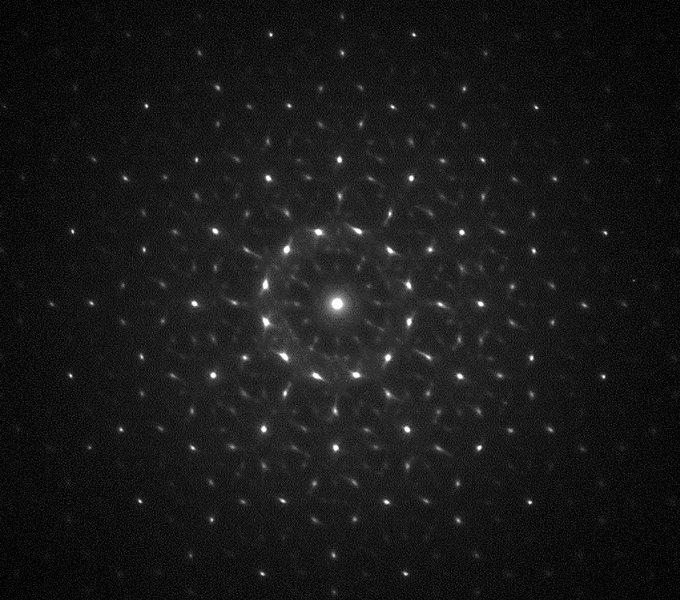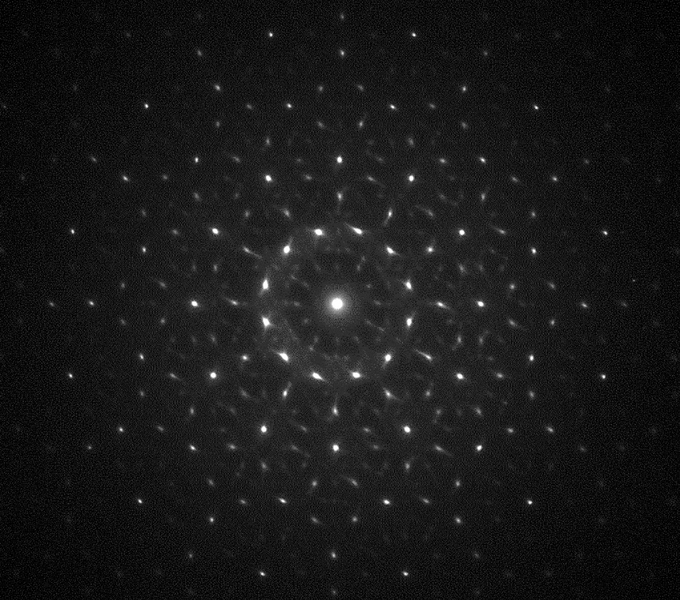Quasicrystal with a “Flashy” Origin
Only a handful of quasicrystals—structures that sit somewhere between crystals and glasses—have been discovered outside of the laboratory. The first was identified in a meteorite and is thought to have been created during a high-velocity impact event. Another turned up in a 2021 study of debris from the site of the world’s first nuclear explosion, which took place in 1945 in New Mexico. Now researchers have found a new quasicrystal in an equally quirky location—a sand dune in Nebraska—with a similarly powerful generation mechanism: the high-intensity electrical discharge of a lightning strike [1].
Scientists became interested in quasicrystals in the early 1980s when electron-diffraction experiments revealed an alloy with fivefold (icosahedral) symmetry that was strictly forbidden for any periodic crystal (see Focus: Nobel Prize—Discovery of Quasicrystals). As it turned out, theorists had hypothesized that such a material could exist, assuming its structure was “quasiperiodic,” meaning that it contains patterns that repeat but not at equal intervals. Subsequent lab-produced quasicrystals have been shown to possess novel electrical, photonic, and mechanical properties that aren’t found in other materials, making them an attractive prospect for materials scientists.
The meteorite and explosion-site quasicrystals were both uncovered by a team that includes Luca Bindi of the University of Florence, Italy, and Paul Steinhardt of Princeton University. In those previous cases, the materials were subjected to extremely high-pressure, high-temperature shock events—analysis of the meteorite sample revealed the temperature reached at least 1200 °C and the pressure 5 GPa, while the New Mexico sample reached 1500 °C and closer to 8 GPa. These transient, intense conditions contorted the materials’ atoms, forcing them to arrange into patterns unseen for usual laboratory conditions.
The explosion-site sample was found in a rock-like substance made of sand that had been fused together with copper wires from a measurement device that had been set up to monitor the atom-bomb test. As a trained geologist, Bindi was aware that similar substances—so-called fulgurites—are created when lightning strikes a beach or a sand dune. He wondered if lightning-fused samples might also contain quasicrystals, so he and the team set about collecting and analyzing the structures of as many fulgurites as they could lay their hands on.
Luck was on their side. In a fragment of a storm-created fulgurite from the Nebraskan Sand Hills—grass-stabilized sand dunes in northern Nebraska—the team found a micron-sized fragment of a quasicrystal with a previously unseen composition and pattern. Specifically, the newly discovered quasicrystal has a dodecagonal—12-fold symmetric—atomic structure. Such ordering is impossible in ordinary crystals, Bindi says, and is unusual even for quasicrystals (both the meteorite and explosion-site quasicrystals, as well as most lab-made ones, have fivefold symmetric patterns). “This was all more than [we] could have hoped for in such a long-shot search,” Steinhardt says.
Like the explosion-site sample, the Nebraskan one contains anthropogenic metal, which the team thinks came from a power line that was downed during the fulgurite-creating storm. Because of the presence of the power line, Steinhardt says that the team cannot definitively attribute the formation of the quasicrystal to a lightning strike. It was either that or an electrical discharge from the power line, he says.
“Bindi, Steinhardt, and colleagues have just made the world an even more interesting place,” says Robert Hazen, a geologist at the Carnegie Institution for Science in Washington, DC. “To me the discovery of [quasicrystals] is one of the great surprises of modern mineralogy. Each new find enriches the story and provides insights.” For example, the formation mechanism of the Nebraskan quasicrystal could provide scientists with new routes to synthesizing these exotic materials. “Others will surely build on these exciting results,” Hazen says.
As the third discovery of a quasicrystal “in the wild,” Bindi says that the new finding takes quasicrystals a step further from laboratory oddity to everyday natural wonder. “To find them in nature means that quasicrystals can be considered a stable state of matter,” Bindi says. Steinhardt agrees, adding that quasicrystals might be much more common than researchers think, they just need to be found. For example, “the fact that we found [a quasicrystal] in a meteorite from our Solar System suggests that they may be formed in star systems and galaxies throughout the Universe,” he says.
–Katherine Wright
Katherine Wright is the Deputy Editor of Physics Magazine.
References
- L. Bindi et al., “Electrical discharge triggers quasicrystal formation in an eolian dune,” Proc. Natl. Acad. Sci. U.S.A. 120 (2022).





